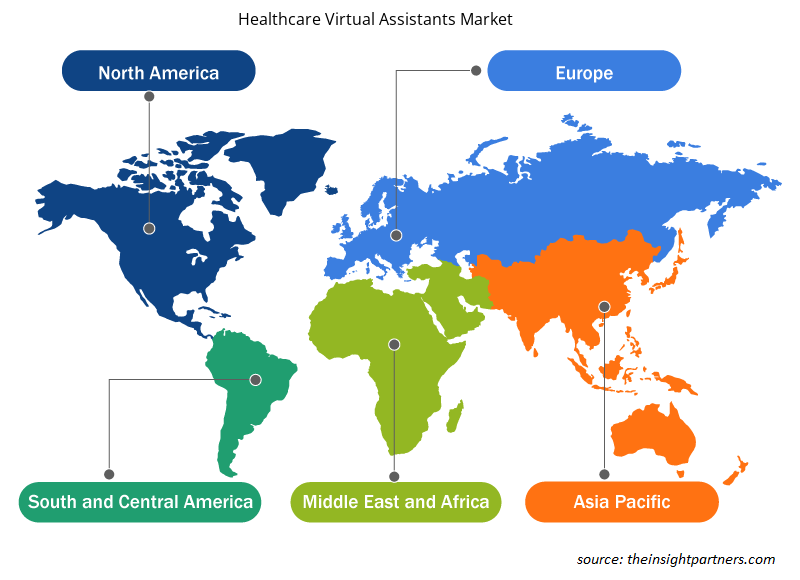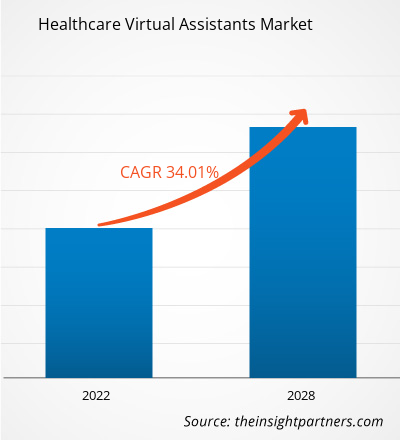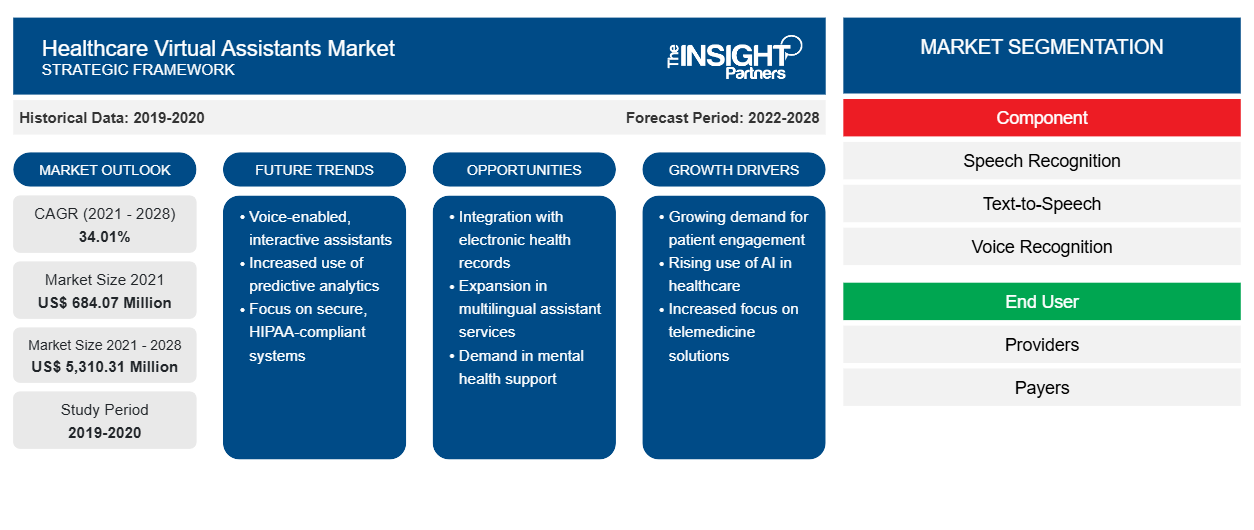[Forschungsbericht] Der Markt für virtuelle Assistenten im Gesundheitswesen soll von 684,07 Millionen US-Dollar im Jahr 2021 auf 5.310,31 Millionen US-Dollar im Jahr 2028 anwachsen; von 2021 bis 2028 wird ein durchschnittliches jährliches Wachstum von 34,01 % erwartet.
Zunehmende Entwicklungen und Fortschritte bei IT-Lösungen für das Gesundheitswesen und die zunehmende Verbreitung von Smartphones mit zunehmenden gesundheitsbezogenen Anwendungen stimulieren das allgemeine Marktwachstum. Laut einem Bericht der American Health Information Management Association ( AHIMA ) sind medizinische Fachkräfte zu einem Zielmarkt für Smartphone-Technologien geworden. In Gesundheitsorganisationen wie Krankenhäusern bieten moderne Smartphones mehr Komfort und Effizienz als herkömmliche Computer. Der Bericht der Weltgesundheitsorganisation (WHO) besagt, dass mobile Gesundheit ( mHealth ) die Gesundheitsergebnisse von Patienten revolutionieren und virtuelle Dienste über ein Smartphone mit medizinischem Fachwissen und Wissen in Echtzeit bereitstellen kann, was insbesondere für Menschen in abgelegenen Gebieten ein Segen ist.
Passen Sie diesen Bericht Ihren Anforderungen an
Sie erhalten kostenlos individuelle Anpassungen an jedem Bericht, einschließlich Teilen dieses Berichts oder einer Analyse auf Länderebene, eines Excel-Datenpakets sowie tolle Angebote und Rabatte für Start-ups und Universitäten.
- Holen Sie sich die wichtigsten Markttrends aus diesem Bericht.Dieses KOSTENLOSE Beispiel umfasst eine Datenanalyse von Markttrends bis hin zu Schätzungen und Prognosen.
Nordamerika wird voraussichtlich zwischen 2021 und 2028 weiterhin eine dominierende Stellung auf dem Markt für virtuelle Assistenten im Gesundheitswesen einnehmen. Die USA halten in dieser Region den größten Marktanteil. Aufgrund der entwickelten IT-Infrastruktur im Gesundheitswesen und staatlicher Initiativen zur Implementierung virtueller Assistententechnologien im Gesundheitswesen wird das Land im Prognosezeitraum voraussichtlich weiterhin ein dominanter Anteilseigner auf dem Markt sein. Darüber hinaus sind die USA der größte Markt für virtuelle Assistenten im Gesundheitswesen, vor allem aufgrund der hohen Nachfrage nach der Installation solcher fortschrittlicher Geräte in Krankenhäusern und Kliniken sowie in der häuslichen Pflege in den USA aufgrund der steigenden geriatrischen Bevölkerung. Abgesehen davon bietet die Präsenz wettbewerbsfähiger Top-Player in dieser Region mit ihren innovativen Produkteinführungen lukrative Möglichkeiten für das regionale Marktwachstum. Im Januar 2019 gaben das New-York Presbyterian Hospital und Philips eine Zusammenarbeit für virtuelle Assistenten im Gesundheitswesen bekannt. Das New-York Presbyterian Hospital hat geplant, seine virtuellen Pflegekapazitäten mit Fernüberwachungsdiensten von Philips zu erweitern.
Markteinblicke
Zunehmende Nutzung von Healthbots / Chatbots für eine qualitativ hochwertige Patientenversorgung treibt das Marktwachstum an
Die COVID-19-Pandemie ist ein eigenständiger Faktor, der für das Wachstum des gesamten Marktes für virtuelle Assistenten im Gesundheitswesen verantwortlich ist. Laut dem Bericht des Weltwirtschaftsforums ( WEF ) ist das Potenzial virtueller Assistenten enorm und mit lukrativen Vorteilen verbunden, die bereits realisiert werden. Daher bietet der Gesundheitssektor eine der umfassendsten Möglichkeiten für virtuelle Assistenten. Beispielsweise helfen automatisierte Texterinnerungen an Termine und Chatbot- Unterstützung Ärzten, über digitale Konsultationen mit Patienten in Kontakt zu treten. In Ruanda, wo es nur einen Arzt und sechs Gesundheitspersonal pro 10.000 Menschen gibt, tragen Gesundheitsbots dazu bei, den hohen Bedarf an Gesundheitspersonal zu verringern. In den kommenden Jahren werden Gesundheitsbots zum zentralen Werkzeug, indem sie KI nutzen, die für die ruandische Sprache und Epidemiologie lokalisiert ist, damit mehr Patienten zu Konsultationen behandelt werden können. Daher können durch solche virtuellen Assistenten eine effektive Nutzung knapper Gesundheitsressourcen erreicht und im Gegenzug die Qualität der Versorgung verbessert und Gesundheitspersonal auf dem Laufenden gehalten werden.
Komponentenbasierte Erkenntnisse
Basierend auf den Komponenten ist der Markt für virtuelle Assistenten im Gesundheitswesen in Spracherkennung, Text-to-Speech und Stimmerkennung unterteilt . Schätzungen zufolge wird das Segment Spracherkennung zwischen 2021 und 2028 den größten Marktanteil ausmachen. Die Spracherkennungstechnologie hat im Gesundheitssektor erhebliche Aufmerksamkeit erlangt. Laut dem Bericht der AHIMA Foundation begann der Gesundheitssektor mit der Implementierung von Spracherkennungstechnologie für medizinische Berichte. Mit kontinuierlichen Verbesserungen der Technologie wurde es für Krankenhäuser notwendig, dass sich Ärzte des Werts dieser Systeme bewusst wurden und an sie glaubten. In den kommenden Jahren könnte die Spracherkennungstechnologie auch eine wichtige Rolle dabei spielen, Gesundheitsdienstleistern dabei zu helfen , Dokumente am Krankenbett zu erstellen. Die oben genannten Faktoren treiben das Marktwachstum für das Spracherkennungssegment voran.
Erkenntnisse für Endbenutzer
Basierend auf dem Endnutzer ist der Markt in Anbieter, Kostenträger und andere segmentiert. Das Anbietersegment wird den Markt in den kommenden Jahren dominieren. Laut dem Bericht der American Telemedicine Association (ATA) bieten virtuelle Assistenten im Gesundheitswesen zahlreiche Vorteile für Patienten und Anbieter. Beispielsweise können Anbieter durch den Einsatz virtueller Assistenten ihre Reichweite erweitern, insbesondere für Patienten, die in ländlichen Gebieten leben, indem sie physische Barrieren bei der Versorgung beseitigen. Außerdem können sie präventive Dienste anbieten, die die Aufklärung oder das Wellness-Coaching der Patienten bei nicht dringenden Gesundheits- und Wellnessproblemen ermöglichen. Die virtuelle Ausweitung der Gesundheitsversorgung kann Anbietern dabei helfen, die Versorgung ihrer Patienten während ihrer Genesung nach einem längeren Krankenhausaufenthalt oder einem chirurgischen Eingriff zu überwachen und zu verwalten oder sogar als Ersatz für die persönliche Versorgung zu dienen, je nach den Bedürfnissen der Patientengruppe, den Möglichkeiten der Gesundheitsorganisation und der Ressourcenverfügbarkeit. Die oben genannten Faktoren tragen zum Marktwachstum im Anbietersegment bei.
Unternehmen, die auf dem Markt für virtuelle Assistenten im Gesundheitswesen tätig sind, verfolgen eine Produktinnovationsstrategie, um den sich weltweit entwickelnden Kundenanforderungen gerecht zu werden und so ihren Markennamen auf dem Weltmarkt zu behaupten.
Markt für virtuelle Assistenten im Gesundheitswesen – Segmentierung
Basierend auf den Komponenten ist der Markt für virtuelle Assistenten im Gesundheitswesen in Spracherkennung, Text-to-Speech und Stimmerkennung unterteilt. Nach Endbenutzer ist der Markt in Anbieter, Kostenträger und andere unterteilt.
Regionale Einblicke in den Markt für virtuelle Assistenten im Gesundheitswesen
Die regionalen Trends und Faktoren, die den Markt für virtuelle Gesundheitsassistenten im Prognosezeitraum beeinflussen, wurden von den Analysten von Insight Partners ausführlich erläutert. In diesem Abschnitt werden auch die Marktsegmente und die Geografie für virtuelle Gesundheitsassistenten in Nordamerika, Europa, im asiatisch-pazifischen Raum, im Nahen Osten und Afrika sowie in Süd- und Mittelamerika erörtert.

- Erhalten Sie regionale Daten zum Markt für virtuelle Assistenten im Gesundheitswesen
Umfang des Marktberichts zu virtuellen Assistenten im Gesundheitswesen
| Berichtsattribut | Details |
|---|---|
| Marktgröße im Jahr 2021 | 684,07 Millionen US-Dollar |
| Marktgröße bis 2028 | 5.310,31 Millionen US-Dollar |
| Globale CAGR (2021 - 2028)CAGR (2021 - 2028) | 34,01 % |
| Historische Daten | 2019-2020 |
| Prognosezeitraum | 2022–2028 |
| Abgedeckte Segmente | Nach Komponente
|
| Abgedeckte Regionen und Länder | Nordamerika
|
| Marktführer und wichtige Unternehmensprofile |
|
Marktteilnehmerdichte für virtuelle Assistenten im Gesundheitswesen: Auswirkungen auf die Geschäftsdynamik verstehen
Der Markt für virtuelle Assistenten im Gesundheitswesen wächst rasant. Dies wird durch die steigende Nachfrage der Endnutzer aufgrund von Faktoren wie sich entwickelnden Verbraucherpräferenzen, technologischen Fortschritten und einem größeren Bewusstsein für die Vorteile des Produkts vorangetrieben. Mit der steigenden Nachfrage erweitern Unternehmen ihr Angebot, entwickeln Innovationen, um die Bedürfnisse der Verbraucher zu erfüllen, und nutzen neue Trends, was das Marktwachstum weiter ankurbelt.
Die Marktteilnehmerdichte bezieht sich auf die Verteilung der Firmen oder Unternehmen, die in einem bestimmten Markt oder einer bestimmten Branche tätig sind. Sie gibt an, wie viele Wettbewerber (Marktteilnehmer) in einem bestimmten Marktraum im Verhältnis zu seiner Größe oder seinem gesamten Marktwert präsent sind.
Die wichtigsten Unternehmen auf dem Markt für virtuelle Assistenten im Gesundheitswesen sind:
- Nuance Communications, Inc.
- Amazon.com, Inc.
- Verient Systems, Inc.
- Microsoft Corporation
- Egain Corporation
Haftungsausschluss : Die oben aufgeführten Unternehmen sind nicht in einer bestimmten Reihenfolge aufgeführt.

- Überblick über die wichtigsten Akteure auf dem Markt für virtuelle Assistenten im Gesundheitswesen
Nach Geografie
Geografisch ist der Markt für virtuelle Assistenten im Gesundheitswesen hauptsächlich in Nordamerika, Europa, Asien-Pazifik, Naher Osten und Afrika (MEA) sowie Süd- und Mittelamerika unterteilt. Der Markt in Nordamerika ist weiter in die USA, Kanada und Mexiko unterteilt. Der europäische Markt für virtuelle Assistenten im Gesundheitswesen ist in Frankreich, Deutschland, Großbritannien, Spanien, Italien und den Rest von Europa unterteilt. Der Markt im Asien-Pazifik-Raum ist in China, Indien, Japan, Australien, Südkorea und den Rest von APAC unterteilt. Der Markt für virtuelle Assistenten im Gesundheitswesen im MEA ist weiter in Saudi-Arabien, die Vereinigten Arabischen Emirate, Südafrika und den Rest von MEA unterteilt. Der Markt in Süd- und Mittelamerika ist in Brasilien, Argentinien und den Rest von Süd- und Mittelamerika unterteilt.
Firmenprofile
- Nuance Communications, Inc.
- Amazon.com, Inc.
- Verient Systems, Inc.
- Microsoft Corporation
- EGAIN CORPORATION
- Infermedica
- CSS Corp
- Kognito
- Babylon
- True Imaging Interactive Inc.
- Historische Analyse (2 Jahre), Basisjahr, Prognose (7 Jahre) mit CAGR
- PEST- und SWOT-Analyse
- Marktgröße Wert/Volumen – Global, Regional, Land
- Branchen- und Wettbewerbslandschaft
- Excel-Datensatz
Aktuelle Berichte
Verwandte Berichte
Erfahrungsberichte
Grund zum Kauf
- Fundierte Entscheidungsfindung
- Marktdynamik verstehen
- Wettbewerbsanalyse
- Kundeneinblicke
- Marktprognosen
- Risikominimierung
- Strategische Planung
- Investitionsbegründung
- Identifizierung neuer Märkte
- Verbesserung von Marketingstrategien
- Steigerung der Betriebseffizienz
- Anpassung an regulatorische Trends





















 Kostenlose Probe anfordern für - Markt für virtuelle Assistenten im Gesundheitswesen
Kostenlose Probe anfordern für - Markt für virtuelle Assistenten im Gesundheitswesen